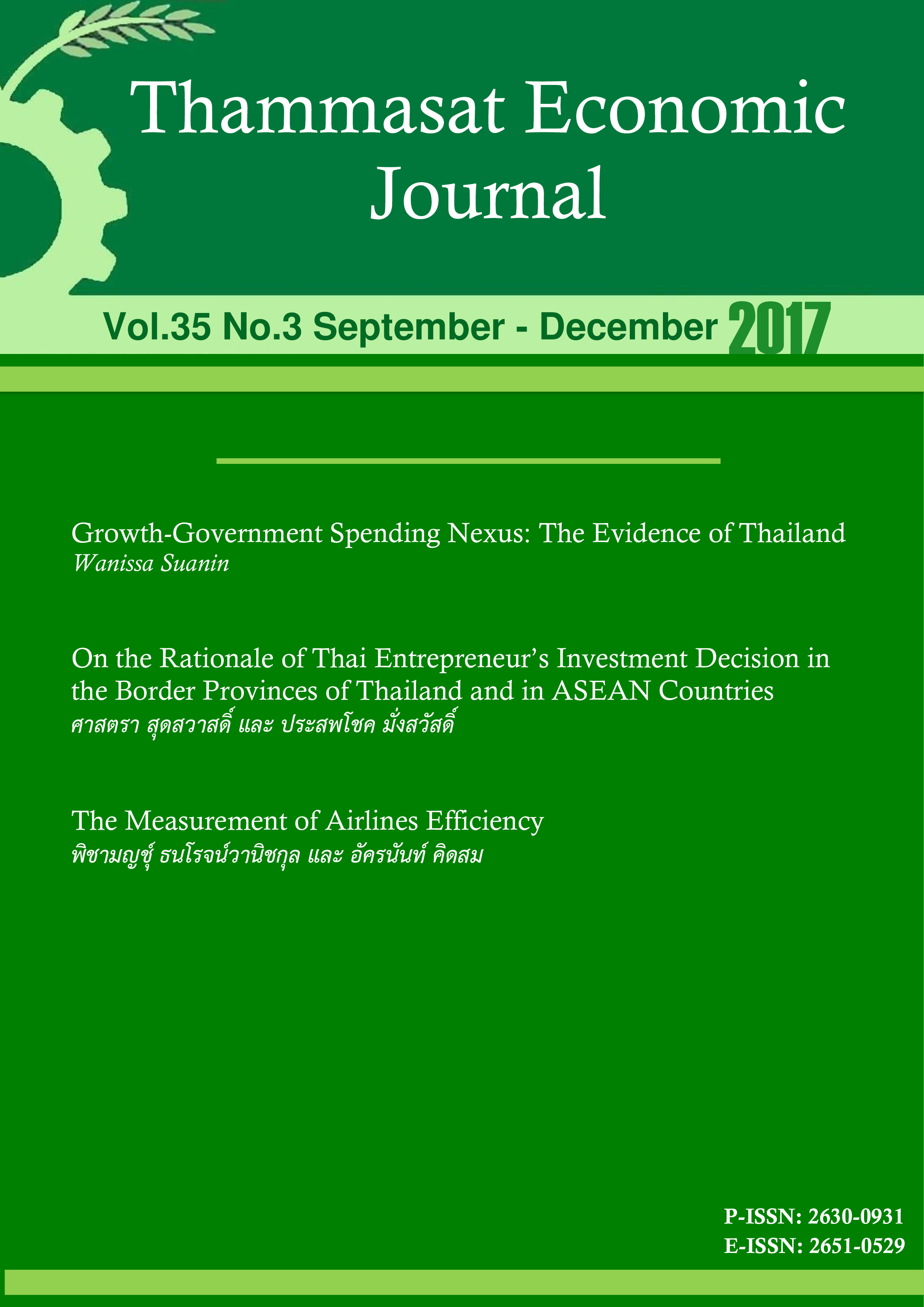The Measurement of Airlines Efficiency
Keywords:
Operating Efficiency, Measurement Efficiency, Airlines EfficiencyAbstract
The objective of this study was to analyze the operating efficiency of ten airlines, comprising Star Alliance Group, Aegean Airlines, Air Canada, Air China, Air New Zealand, All Nippon Airways, Copa Airlines, Croatia Airlines, Lufthansa, Thai Airways and Turkish Airlines, in the period of 2010 to 2014 paying particular emphasis to technical efficiency and operating efficiency indeces. The methodology for measuring efficiency involved Data Envelopment Analysis (DEA) under a BCC Model (input – oriented) focusing on seven variables for analysis, five inputs and two outputs. The inputs were made up of personnel expenses, aircraft fuel, maintenance expenses, available ton kilometers and assets; while the outputs were composed of revenue passenger kilometers and passenger revenue. In addition, Du Pont Analysis was employed to analyze financial efficiency through Return of Equity ratios involving four variables under analysis; Net Profits, Sales, Total Assets and Equity.
The results from the DEA revealed which airlines were functioning efficiently in terms of technical and operational considerations during the period 2010 - 2014. AI Inefficient airlines could potentially improve their inputs and outputs by following the reference sets outlined. The results from the Du Pont Analysis yielded informative data on the relative operational efficiency of business activities for the airlines concerned in comparison with industry benchmarks.
References
Aegean Airlines (2014). 2010-2014 Annual report (online). Retrieved from http://en. aegeanair.com.
Air Canada (2014). 2010-2014 Annual report (online). Retrieved from https://www.air canada.com.
Air China (2014). 2010-2014 Annual report (Online). Retrieved from www.air china.com.
Air New Zealand (2014). 2010-2014 Annual report (online) Retrieved from www.airnew zealand.com.
All Nippon Airways (2014). 2010-2014 Annual report (online). Retrieved from www.ana.co.jp.
Arjomandi, A., & Seufert, J. (2014). An evaluation of the world's major airlines' technical and environmental performance. Economic Modelling, 41, 133-144.
Chanpayom, P. (2003). The airline business: Global airline alliances. Thammasat Business Journal, 26(97), 41-60.
Chutiwong, N. (2005). Microeconomic Theory (8th ed.). Bangkok, Faculty of Economics, Chulalongkorn University.
Copa Airlines (2014). 2010-2014 Annual report (online). Retrieved from www.copaair.com.
Croatia Airlines (2014). 2010-2014 Annual report (online). Retrieved from www.croatiaairlines.com.
Farrell, M. (1957). The measurement of productive efficiency. Journal of the Royal Statistical Society, 120(3), 253-290.
Fongphet, S., Awirojthananont, T., & Hantakul, J. (2012). Lectures of business finance. Bangkok: Faculty of Commerce and Accountancy, Thammasat University.
International Air Transport Association. (2015). 2010-2015 Annual review (online). Retrieved From www.iata.org.
Kanchanawasri, S. (2002). Evaluation Theory (3rd ed.). Bangkok, Chulalongkorn University.
Lufthansa (2014). 2010-2014 Annual report. (online). Retrieved from www.lufthansa.com.
Mahanon, P. (1986). Evaluation of organization effectiveness. Bangkok: Odian Store.
Ministry of Transport. (2011). Strategic plan of ministry of transport 2011-2015 (Revision). Bangkok: Strategy and Planning Division, Office of the Permanent Secretary, Ministry of Transport.
Niyomchan, M. (2009). The measurement of efficiency comparison between Thai airways and Singapore airlines. Thesis, Master of Economics, Department of Economics, Kasetsart University.
Pasunon, P. (2005). An efficiency measurment of organization by data envelopment analysis. Thammasat Business Journal, 28(108), 33-42.
Pasunon, P. (2006). An efficiency measurment of organization by data envelopment analysis: CCR and BCC models. Thammasat Business Journal, 29(112), 31-44.
Pasunon, P. (2006). An efficiency measurment of organization by data envelopment analysis: RCCR model and excel calculation. Thammasat Business Journal, 30(114) 25-38.
Pornsooksawang, S. (2010). Financial performance and bankruptcy risk of Thai bank. Thammasat Business Journal, 33(125) 32-45.
Rai, A. (2013). Measurement of efficiency in the airline industry using data envelopment analysis. Investment Management and Financial Innovations, 10(1), 38-45.
Songsrirote, N., & Singhapreecha, C. (2006). Efficiency measurement approaches and limitations. Applied Economics Journal. 13(2) 79-99.
Star Alliance. (2015). About star alliance (online). Retrieved from http://www.star alliance.com/en/about.
Suebpongsakorn, A. (2012). Process of data envelopment analysis (DEA) and technical efficiency measurement. Journal of Economics, Chiang Mai University, 16(1), 43-82.
Thai Airways International Public Company Limited. (2014). 2010-2014 Annual report. Retrieved From www.thaiairways.com.
Turkish Airlines (2014). 2010-2014 Annual report (online). Retrieved from www.turkish airlines.com.
Untong, A. (2004). Manual of DEAP 2.1 program for DAE efficiency analysis. Social Research Institute, Chiang Mai University.










